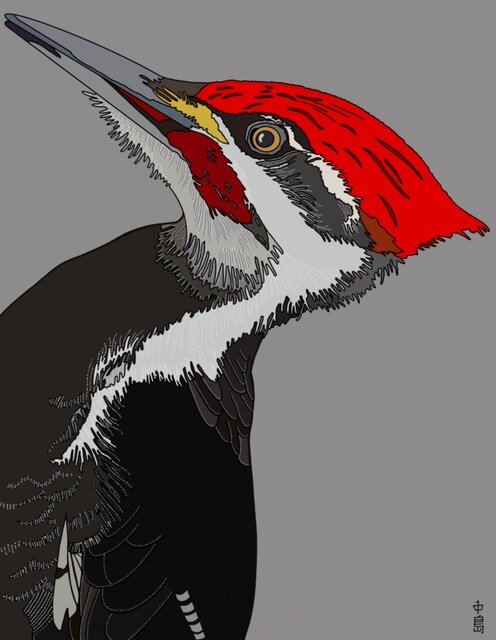Imagine a marble dropped from a considerable height onto a wood floor. Imagine the sound it makes, like a low, rhythmic thrumming that bounces into the space until it settles, silent. Now imagine hearing this sound as you quietly walk through a forest thick with trees, many of them old or decaying. This sudden drumming stops you, and you look out into the murk of the woods and see it. There, scaling up and down the bark of a tree like the most skilled rappeler, is a pileated woodpecker. She hammers away unconcerned, and the staccato drum of her beak reverberates, a metaphorical marble dropped from a great height.
Illustration by L. Hisako Nakashima
I am awed by the sound of a pileated’s drumming, so low and even that it soothes me. I am moved to celebrate its din as it scours through its own wreckage in search of carpenter ants and other, delicious woodboring beetle larvae. It uses its long, prickled tongue to pull the bugs from the bark. This woodpecker, the largest of its kind in North America, passes through the woods creating its ruckus, sometimes hammering out large, unbelievable rectangles in the sides of dead trees, and sometimes calling out with its sharp, staccatoed shout like a burst of laughter jubilant and uncanned. Like most woodpeckers, the pileated is punkish in its appearance. A crest of scarlet red feathers sits atop both the male and female’s heads like vibrantly dyed and gelled hair. The males don stripes of that same scarlet that brighten their cheeks with distinct lines, while the females don stripes of black. In flight, they look like elegant, paper hand fans as their wings reveal a band of white that is mostly hidden when perched.
The pileated embraces death. In fact, it seeks it out, scouring the woods for dead and decaying trees and logs where it spends its time picking away at the remains in search of its next meal. It makes a home in the dead, too, often spending weeks carving out a beautiful oblong crevasse on the side of a tree, in which the female lays her eggs. Here, a breeding pair will alternate sitting for over two weeks until eventually, from within that space carved out of a death, new life will emerge. Once, John J. Audubon climbed a tree to reach his hand into the nest of a pileated woodpecker. He brushed the bottom with his hand. He stole the eggs. His morals did nothing to dissuade him from taking what was not his. He returned to the nest once a new set of eggs hatched, and stole the nearly fledged chicks, too. But he could not sate them. They raged and refused his hospitality into the winter months as if they understood all that had been stolen from them. When they finally escaped, he watched them fly into an apple tree, and he marveled at the ease with which they used their once-captive wings. But what did he expect? Did he truly believe their time with him would make them forget their birdness?
There was a time when the pileated’s numbers were steeply declining in the eastern United States. The clearing of forests had made it so. But time can sometimes be generous, and this hardy bird worked its way back from the brink so that today, it thrives with little concern. This year, the American Birding Association has named the pileated woodpecker its Bird of the Year. It was chosen for being an “emblem of both the wild woods and the adaptability of birds to anthropogenically altered spaces.” I think of John J. Audubon stilled by the effortless flight of his captured birds and know that some things are learned before you are born. For the pileated, a bird hatched in the dark and surrounded by decay, it must know the meaning of death intimately. How else to explain its triumphant return to this world, ready to adapt to its new life among the buildings and the trees?
Sources
- All About Birds: Pileated Woodpecker, Cornell Lab of Ornithology
- National Audubon Society, Guide to North American Birds: Pileated Woodpecker by Ken Kaufman
- National Audubon Society, John J. Audubon’s Birds of America: Pileated Woodpecker
Miyako Pleines
is a Chicago area writer who shares her thoughts on birds and nature in monthly essays for Chicago Audubon.



